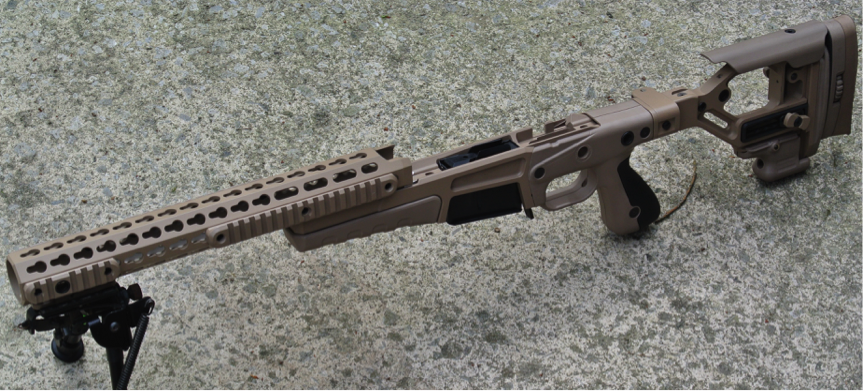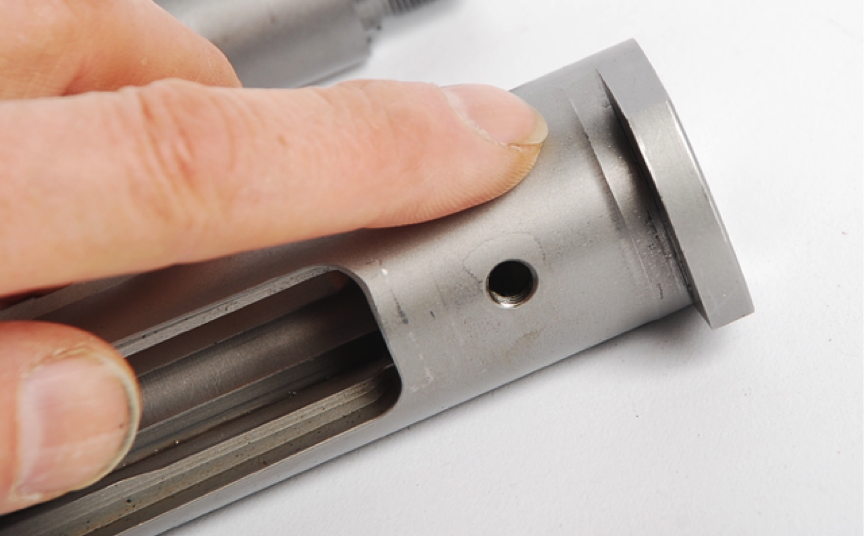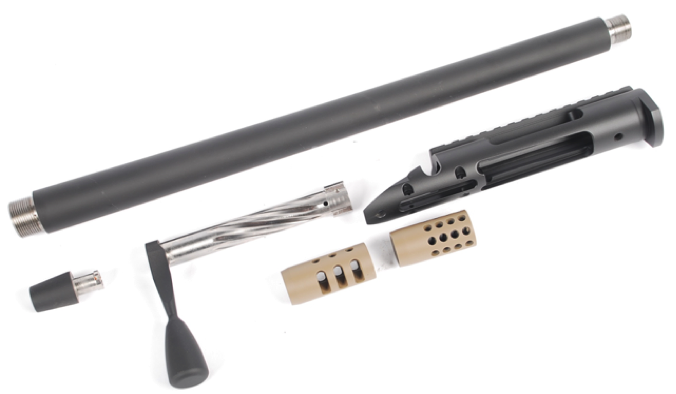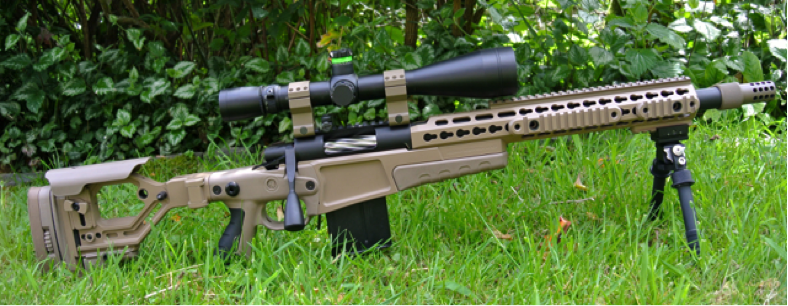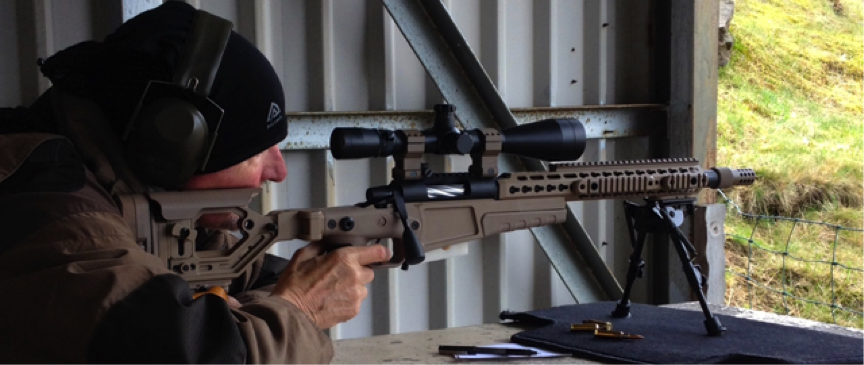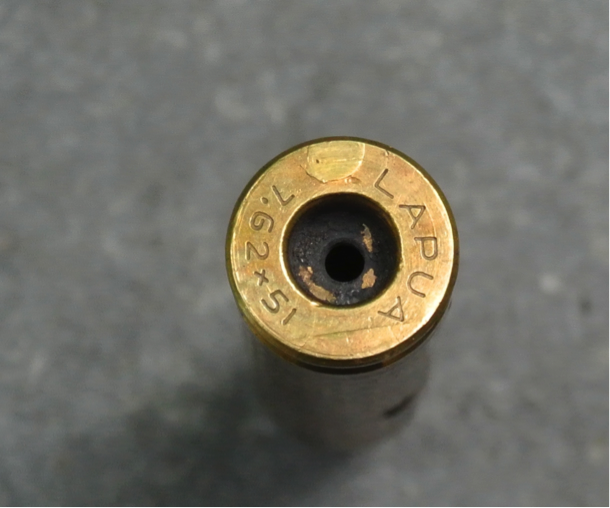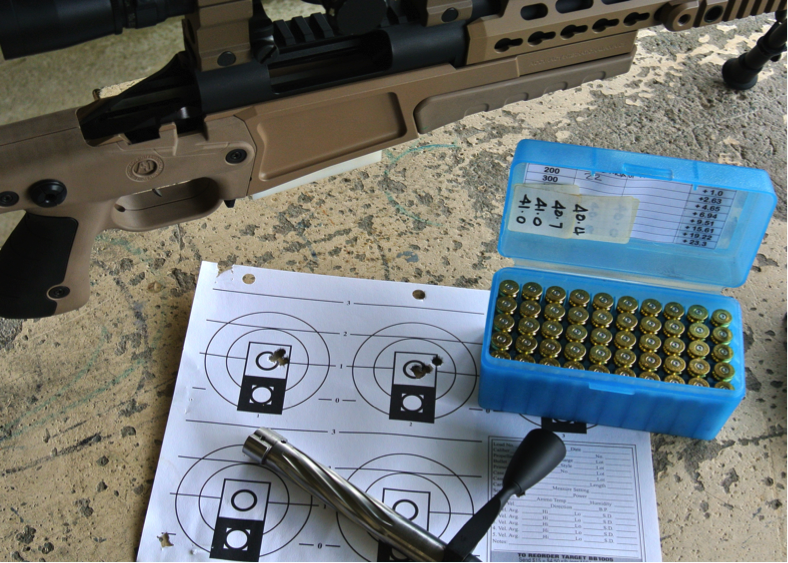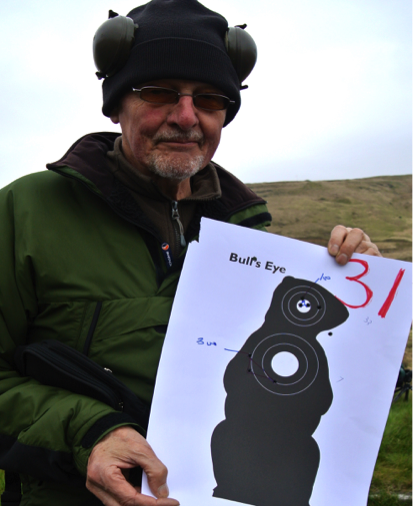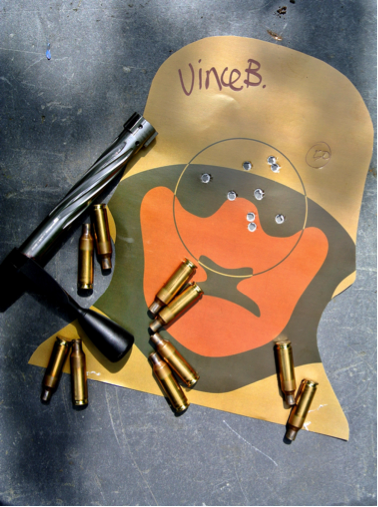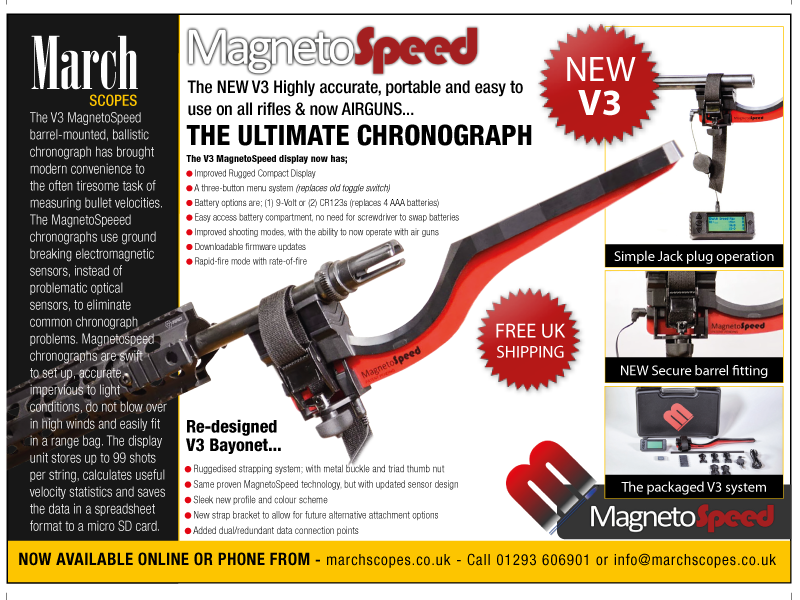If it weren’t for the near four-grand price-tag, wouldn’t we all have an AI in our cabinet? Since its inception in 1978 when the late great Malcolm Cooper founded Accuracy International Ltd, the rifle has always topped the desirability charts, be you a plinker, tailor, soldier or serious competition shooter.
Although many shooters didn’t like the plastic thumb-hole grip and thick, ugly trigger-guard of the original, overall the rifle was a ‘looker’ and with its superb magazines, soon set the standard for tactical rifles. Not only is it a looker, it’s also a shooter and has a reputation for delivering outstanding results – even with factory ammunition. In addition to a very robust multi-lugged custom action, the AI’s unique bedding system certainly adds to its performance. Malcolm Cooper was a multiple shooting World Champion and he well knew what contributed to a rifle’s accuracy – a stiff action, properly bedded in a strong, rigid stock is essential – the hall-mark of an AI rifle.
Yes, you can build a great-looking tactical rifle for far less money and, with carefully prepared hand-loads, it may well equal or even out-shoot the AI – but with factory ammo in hostile environments would it still be shooting and functioning 100%? This is what separates the AI from the rest. Plus, its easy ability to switch barrels and maintain its zero, really puts the AI head and shoulders above any other production rifle.
Initially, the AI was difficult to get hold of for civilian shooters but following the liquidation of the original company in 2005, Accuracy International was purchased by a British consortium, which fortunately included two of the company’s original design team. Eventually, civilians were recognised as legitimate customers and not only that, a drop-in replica chassis system became available to satisfy all the AI fanatics who loved the look of the rifle but not the price-tag! Not surprisingly, drop-in Remington AIs vastly outnumber the genuine article in civvy circles and it’s rare not to see an AI chassis on the firing-point, be it plinking or serious competition.
I’m not surprised however to find that there are always a good number of genuine AIs on sale secondhand. Buyers pay a hefty price without really asking themselves how the rifle will be used and often find that there’s little opportunity to make use of the rifle’s outstanding attributes – beyond the reason it was purchased – i.e. pride of ownership. Outside of the military arena, where it can really show its true ability? Twenty-five years ago and the AI would have held its own in any company – but what was there back then in pre-F Class days for the serious long-range competition shooter with a scoped rifle?
Now, however, shooting disciplines have become very specialized – the Practical/Civilian Service Rifle guys have switched to the straight-pull AR 15 clones, proper Tactical shoots are few and far between in the UK and although the ever popular F Class is shootable with an AI, the muzzle-brake must be removed and the standard 308 barrel is really way too short for 1000 yard stuff. Surprisingly, one of our shooters has turned-in some amazing groups in 600 yard benchrest with his AI and still holds a UKBRA record or two.
The new AI chassis system
A couple of years ago the AI chassis was revamped – nay, it was completely redesigned and I like it. In fact I absolutely love it! So much so that my existing tactical rifle – that I use regularly for McQueen shoots and the odd tactical comp. was moved-on. A new build is on the way!
Well OK, I jumped the gun – I’d already sold my McMillan A5 stocked 6.5×47 when I found out that there was a 16 week delivery on the new AI stock! Aaargh. But, those 16 weeks have finally crawled by and before me is a cardboard box containing my new toy. For those not familiar with this stock, it consists of three CNC’d aluminium sections and a few plastic bits as well.
At the front end, we have an octagonal-shaped hand-guard which shrouds the barrel. The hand-guard is perforated for cooling, weight and appearance and the slotted ‘perforations’ also form an efficient attachment system for accessories and additional Pic rails – four of which are included in the package.
Here’s what you get in the box – excluding the bipod
The fore-end attaches to the centre-section with two 6mm socket screws. This joint is helped by the snug ‘wedge’ fit between the two components and eliminates any sideways movement and of course it has to be perfect – the fore-end also supports the weight of the rifle when shooting from a bi-pod. A Harris-type bi-pod stud is thoughtfully affixed to the fore-end via another short length of rail which could be substituted with one of the shorter supplied Pic rails if you were to use say an Atlas bi-pod.
The rear-end – or butt-stock – is a complex piece of kit which is hinged to the main centre-section, allowing the butt to fold, reducing the overall length of the rifle by eight inches – the overall length of mine is just 30 inches when folded. The hinge is extremely robust and of close tolerance, without the slightest ‘slop’ and, when clicked into position, becomes absolutely ‘as one’ with the centre-section. Extensive adjustment is offered via the raising cheek-piece and the multi-adjustable soft rubber butt-pad, which can be raised, extended or angled. A small ‘bag-rider’ is fixed to the underside of the butt via another short Pic rail, which provides a useful means of supporting the back-end of the rifle.
The centre-section houses the action and incorporates the mag-well which, on this new version of the stock, is heavily cut-away on the left side. I haven’t found the reason for this as yet but it will no doubt become apparent in use. I suppose it does allow a better grip when removing and inserting the flush-fitting five-round magazine that is included with the stock-package.
The stock may be round but is your action? The BAT has a small raised area behind the lug so a small amount of machining was needed to accommodate this
The inlet and action-screw holes are cut to suit a Remington short action – or one of identical proportions. This is true of my BAT VR action – except that the built-in recoil-lug is thicker than a Remington factory lug and therefore a small amount of machining is required to get the holes to align – simple if you have access to a milling machine. Also, the circular BAT action-body has a ‘bump’ just to the rear of the aforementioned lug, which means a bit more machining to ensure that the action beds 100%.
A word about bedding. Bedding a round action into a matching CNC machined half-round recess should, in theory, provide 100% contact – the perfect bedding. However, past experience has taught me otherwise – ‘round’ actions aren’t always CNC-round! If it shoots – fine, if not be prepared to sit the action on a very thin layer of bedding compound, which will absorb those minute discrepancies. Actually, the AX attempts to overcome this problem by offering two ‘rails’ for bedding support. The action has a much better chance of 100% ‘seating’ with this arrangement and, unless I have accuracy issues, I’m happy to go with this method.
A small amount needs to be machined off to accommodate the BAT’s thicker recoil-lug. Note the ‘bedding’ rails
Other stock and butt configurations are offered by Accuracy International, plus there are alternative colours. Mine, as you can see from the photographs, is finished in what AI call ‘pale brown’ which is not dissimilar to the better-known Magpull FDE (flat dark earth). Alternatively I could have had green or all black but, the tan colour is rather fashionable at the moment – n’est pas? Oh, and that thick, ugly plastic trigger-guard is still there – but I can live with it!
The Build
Whilst over in Germany in March at the IWA Show I got to look at quite a few AIs and the pale brown version really stood out. If you want to spoil the look of an AI just stick a 30 inch shiny barrel on it and it suddenly looks odd – out of proportion – and it is, though I don’t doubt that it will still shoot as well as anything on the planet. The AI that caught my eye though was a real shorty – it looked more like an AR15 – wow, that’s how mine’s going to look!
Unfortunately, this means that the barrel will be a scant 18 inches in length. OK, no 1000 yard work maybe with this gun (well of course I’ll try it) but it should be perfect for McQueen and tactical comps out to 600 yards. I’m sticking with the 6.5×47 Lapua cartridge – for me it’s the perfect round for short to mid-range work, delivering benchrest accuracy – thanks to the high quality of the Lapua brass.
My reamer has a 0.294in. neck, which I call a ‘no-turn neck’. I would never advise running a ‘working’ tactical rifle this close but, this is a play-gun and will always be shot on range, cossetted and cleaned frequently. What’s more, the BAT VR action is more benchrest than tactical despite its mag cut-out and integral Picatinny rail. To speed-up the cycling, I’ve already installed a Badger-style bolt-knob and, with its fluted bolt, the BAT is now slick as a greased pig.
I happen to think that this is just about the finest action available for a ‘toy’ tactical but, its tight tolerances mean that it wouldn’t survive long in a true tactical environment. A grain of sand in the action would probably lock the whole thing solid! Stick with a Surgeon or Badger Ordnance if you are building a true tactical rig – or even a Remmy.
I’m installing a muzzle-brake and I have two to choose from – a military-style ‘blast everybody off the point’ brake and a pepper-pot brake. Either will do the job and I like the look of the laterally-ported brake but, in deference to those shooting close by, I’ll probably opt for the pepper-pot. The barrel – a Bartlein 1 in 8 twist is heavy and, at 18 inches, I can afford to make it ‘benchrest’ dimensions – 1.25 in. tapering to an inch at the muzzle. Yes, for McQueen, I’m looking for real accuracy.
The McQueen
Over the last few years, the McQueen comp. has become very popular at my home club and many shooters are now McQueen ‘specialists’ using a rifle that does little else. We shoot at two distances – 200 and 300 yards. A possible 50 is on offer to anyone putting all ten shots in the four-inch circle, making for a 100 maximum over the two distances. The time for each exposure is just three seconds at any of ten windows on the McQueen wall and, we shoot in pairs so first you must pick out your own target!
A few years ago anything over 90 (ex 100) would be good enough to secure the win but now, a 90 will not even get you in the top ten! Several ‘fifties’ will be posted and it’s not unusual for a perfect 100 to take the win! This is damn good snap-shooting by anyone’s standard – especially off a bi-pod with no back-bag permitted.
Pimp my gun!
With the barrel threaded and chambered, all the bits are now ready for assembly and it’s time to pimp the AX a little. I’ve decided to go for a bit of Cerakoting. My local shop – Osprey Rifles – is run by Stuart Anselm who is a factory-trained Cerakote specialist and always has a large range of colours available and Magpull FDE is one of the most popular. I’m going to Cerakote the BAT action and barrel in flat black but, on Stuart’s advice, the bolt-body will be left ‘as is’ – the BAT’s tolerances are too tight even though the Cerakote is only one-thou. thick. The brake and scope-rings will be picked-out in FDE.
First job is to disassemble everything and sand-blast all the components – not just to remove the existing finish but also to give a good key for the paint. If you’re like me, you probably think sand and firearms should be kept as far apart as possible but, after blasting, all items are thoroughly cleaned and then degreased. The Cerakote can now be sprayed on and baked at 120 degrees centigrade for a couple of hours.
Although a total strip-down can be time consuming, Stuart believes that this is the only way to do a proper job. Action face and barrel-shoulder should not be Cerakoted however as this will alter the headspace ever so slightly, so careful masking is required. The charge for all this work – stripping, blasting, degreasing, masking, painting and reassembly was a mere £150 – great value considering the time and work involved.
Ready for assembly after Cerakoting. I have a choice of muzzle-brake
The rifle now looks like something from IKEA and putting it together isn’t much different – just two Allen keys are needed to assemble the AI stock and install the barreled-action! Even though I left the bolt-body unpainted, it’s now a little on the tight side due to the dusting of Cerakote on the inside of the action! A little oil and some ‘elbow grease’ soon has it sliding smooth as silk.
What do you think guys? Does that look the dog’s or what? Can’t wait to go and do some shooting. I know it’s going to be great at short-range but I’ve got to try that stubby barrel at 1000 yards! Although the short barrel has at least saved some weight, it’s by no means a light rifle – at just over 15lbs. with scope and bi-pod.
The other stuff
Two things we haven’t mentioned – scope and trigger. As you can see, my scope is a Leupold MK4 in 8.5-25 magnification with mil-dot ret. mounted on high Burris rings to clear the tubular fore-end. My trigger choice again is very un-tactical – a Kelbly 2oz benchrest trigger. Yes, yes, I know – too light for a tactical rifle but, all my rifles have benchrest triggers and 2oz triggers are the norm to me now but, having said that, I would be reluctant to use a 2oz trigger for off-hand shooting.
Let’s take it to the range
Lapua offer 6.5×47 factory ammunition in 108, 123 and 139 grain configuration and I’ve tried all three but I’ve always thought that the 123gn bullet is the ‘natural’ weight for the 6.5×47. However, Lapua now do a 120 grain 6.5mm bullet in the ‘L’ series and I’ve found the ‘L’ bullets to be very accurate in 6mm guise so I’ve got to give the 6.5 version a try. I’ve always run my 6.5x47s on Vihtavuori’s N550 powder – it nicely fills the case and gives great velocity and accuracy so I’m off to the range with a selection of loads to shoot some groups. My choice of 18 inch barrel means I’m not too obsessed with velocity but it’s always nice to know, so I’m taking along the Magnetospeed chronograph.
Initial testing to run-in the barrel
My approach with new barrel is always the same – what will it take? In other words, what velocity will it deliver before it becomes over-pressure. How do we ascertain this? Firstly, consult your reloading manual for a ‘starter’ load with your chosen powder. Then, load about ten rounds – increasing the load a third of a grain at a time. Shoot these over the chrono and look out for pressure signs – flattened primers, cratered primers, sticky bolt-lift.
Carefully examine each of the ten (if you get that far) fired cases for these tell-tale signs. The shiny circle on the casehead – where the brass has flowed into the boltface ejection-pin hole means that you’ve found max. pressure. DO NOT GO ANY FURTHER! In fact, if you shoot at this loading, your brass won’t last long so back-off the load a grain or so and look for an accuracy load.
You can clearly see how the brass has flowed into the ejector-pin hole on this 7.62 case. STOP – this is over pressure, back-off the load a grain or so.
My ten loads using Vit N550 went from 39.8 to 42.5gn and, loaded with Lapua’s 120 grain Scenar L bullets, max. pressure – the form of sticky bolt-lift – occurred at 41.6 grains but there was no marking of the brass from the ejector-pin hole. With a stress-fire comp. like the McQueen, the rifle must run smoothly so I backed-off to 40.7gn. and started to shoot some 5-shot groups. I’m using Forster dies with the Benchrest Ultra-seater – this die loads very straight rounds.
I don’t load into the lands for anything but benchrest – I’m staying about 10 thou. off and pretty quickly, I have an accuracy load. None of my groups was greater than ¾ of an inch but my best occurred at 41.0 grains dead and my average m/v over the five rounds was 2875 fps. A really nice group measuring well under a half MOA.
The 2800 plus muzzle-velocity pleasantly surprised me – though with an 18 inch barrel, am I really interested in speed? It does mean however that I can run the figures through my JBM ballistics prog. and at least get some come-ups. I had to take the brake off to fit the Magnetospeed, so the next job is to confirm my load works with the brake in place and without the chrono. strapped to the muzzle.
There has been some discussion as to whether hanging the Magnetospeed off the end of the barrel has any effects on barrel harmonics and thus accuracy. Most shooters don’t seem to think that it affects accuracy but I need to confirm that my load is still good with the brake back on.
To fine tune the load and confirm accuracy with the brake in place, I loaded up three groups of five rounds at 41.0, 40.7 and 40.4 grains of Vit N550. The target confirmed that my 41.0gn. load (top left in the pic) was still the best load without the Magnetospeed and with the brake in place.
The 40.7 was also promising (top right) with four in a tiny group but one flyer. 40.3 gn. opened up a little but still only around half an inch. We’ll settle on 41.0 grains (top left target).
DON’T FORGET – THESE LOADS WERE SAFE IN MY RIFLE. THEY MAY NOT BE SAFE IN YOUR RIFLE. AS ALWAYS, REFER TO YOUR RELOADING MANUAL AND WORK UP THE LOAD SLOWLY IN SMALL INCREMENTS – SAFETY BEFORE CONVENIENCE!
First comp
Now, we’re all set for a McQueen comp. but first, it’s Diggle’s Great Egg Shoot. I usually shoot one of my long-range benchguns – last year I broke the egg with my 6mmDasher but I can’t wait to shoot the AX!
A nice three-shot group in the head bull got me first place at the 100yd stage and third overall
A perfect 50 in my first McQueen competition, not as good at 300 yds but another third place
The Egg Shoot is contested at 100, 300 & 500 yards, cumulating with one shot at a hen’s egg at 500 yards. Well, not too bad an effort with a win on the 100 yard stage with a nice little three-shot group in the head-bull and third place overall. Yes, I failed to break the egg – then again so did 37 other shooters, with only Mike Marsh picking up the £100 bonus.
Overall, I love the way the rifle handles – the short barrel and pepper-pot brake sounds noisy but recoil is minimal and it’s easy to retain the target in the scope, so it should be spot-on for the McQueen. My chance came just a couple of weeks later and I was well pleased to shoot a perfect 50 first time out.
What an easy way to put together an accurate tactical rig that shoots well and looks the part. The AX chassis is not cheap but remember, you will save on bedding costs over a McMillan A5 or similar fiberglass stock. All you need is a barreled-action and two Allen keys………
Thanks to Osprey Rifles www.ospreyrifles.com for supplying the stock and the Cerakoting and to March Scopes UK www.marchscopes.co.uk for the Magnetospeed.


